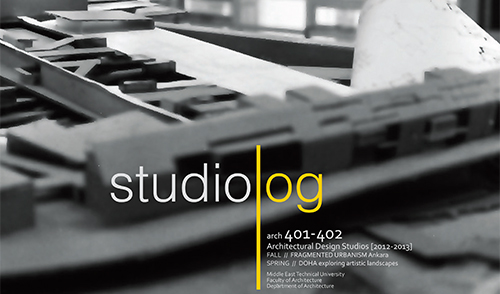
Since its establishment in 1956, the architectural studio has been the mainstay of design education in the METU Department of Architecture. The aim of this first-degree professional program is to educate and train architects who are capable of practicing within their field in both a national and worldwide context. Providing four years of education with eight major studio courses, the department maintains a strong methodological approach to design thinking. In the Fourth-Year Design Studios (401 and 402) the students engage in two projects in which they undertake a comprehensive exploration of the theoretical, contextual, programmatic and material basis of the given subject. The content of the two studios is differentiated and complementary: in the fall program, emphasis is upon the generative role of the urban context, while in the spring program the students look at how a complex building can be integrated into an actual site.
The fall project begins with a thorough research of existing conditions, supported by contemporary theories and methodologies in urban design, with the goal being to make an original contribution to a specified design assignment through the adoption of multiple approaches to multifaceted urban design concerns. The demonstration of a high level of creativity and critical skills is encouraged in situating and negotiating significantly complex architectural and urban programs of all scales into national or international contexts. "Context" is conceptualized and reinterpreted for different cities, such as Budapest, Berlin, Rotterdam, Tirana and Doha, so as to displace and shift the local definitions of the term. Working in a different country provides the students with the opportunity to engage with dissimilar architectural cultures that have been shaped by different social, economic and legal concerns. The development analytical skills and active involvement in the critical understanding, development and definition of an architectural program for an urban condition are the major goals of the research studio. In the spring semester, project briefs emphasize the significance of functional complexities, basic legislative frames and building codes, and structural and infrastructural issues, as much as socio-political and ideological realities. Developing an awareness of the historical and natural assets of the design context help the students to take a critical personal stance and ethical responsibility towards issues related with cultural heritage, society and the environment. Furthermore, they are encouraged to work on the complex and specialized architectural conditions defined in a theoretical framework. Both studios emphasize the generative role of architectural programming in the formation of physical and social conditions, and utilizing liable design strategies, the students analyze contextual and programmatic issues in the development of conceptual and practical approaches to the architectural complications.
This work brings together the project presentations of the students, comprising conceptual, experiential and technical descriptions of their projects, as well as briefs from the weekly seminars and lectures given related to the issues of topical relevance to the design studios.
Studio Instructors:
Prof.Dr. Ayşen Savaş Sargın- Inst. Agnes van der Meij-Teaching Assitant.Seray Türkay-Student Asst. Pınar Uz
Preface
By Dean Ali Cengizkan (Prof.Dr.)
This Studio Logbook is a presentation of the research processes and design outcomes of the fourth-year design studio for the 2012–13 academic year. The METU Department of Architecture has adopted a new approach to design research, with the inclusion of a series of lectures provided by interdisciplinary designers, critics and historians from around the world. In this creative environment, students become active participants in the development of novel design methods and disciplinary interfaces.
This studio book documents a two-year effort of studio instructors and assistants, covering two semesters of work conducted in local and international contexts. The lecture notes have been edited chronologically into their most abstracted versions, while the student projects have been represented in a standard format. Following this approach, the intention has been to ease the comparison of different approaches to similar conditions rather than homogenizing the otherwise diverse answers to complex problems.
This book would not have been possible without the creative, informative and knowledgeable input of both students and lecturers. I would like to take this opportunity to extend my gratitude to studio masters Prof.Dr. Ayşen Savaş Sargın, Inst. Agnes van der Meij, Research Assistant Seray Türkay and Student Assistant M. Pınar Uz.
